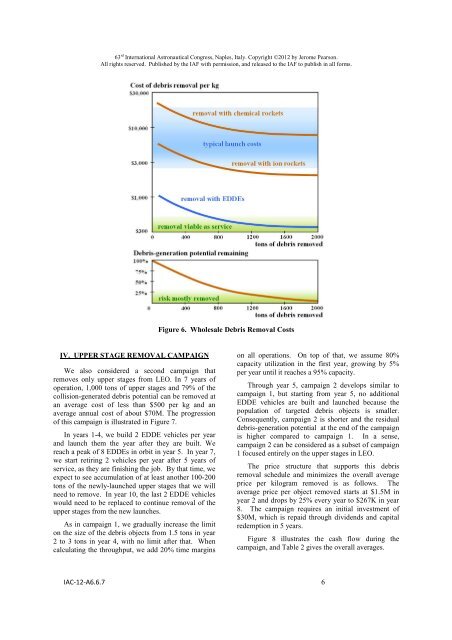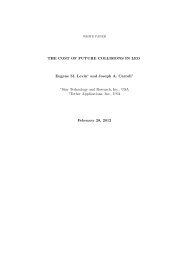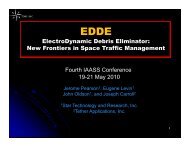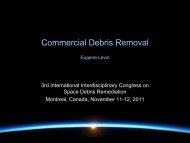Affordable Debris Removal and Collection in LEO - Star Technology ...
Affordable Debris Removal and Collection in LEO - Star Technology ...
Affordable Debris Removal and Collection in LEO - Star Technology ...
You also want an ePaper? Increase the reach of your titles
YUMPU automatically turns print PDFs into web optimized ePapers that Google loves.
63 rd International Astronautical Congress, Naples, Italy. Copyright ©2012 by Jerome Pearson.<br />
All rights reserved. Published by the IAF with permission, <strong>and</strong> released to the IAF to publish <strong>in</strong> all forms.<br />
Figure 6. Wholesale <strong>Debris</strong> <strong>Removal</strong> Costs<br />
IV. UPPER STAGE REMOVAL CAMPAIGN<br />
We also considered a second campaign that<br />
removes only upper stages from <strong>LEO</strong>. In 7 years of<br />
operation, 1,000 tons of upper stages <strong>and</strong> 79% of the<br />
collision-generated debris potential can be removed at<br />
an average cost of less than $500 per kg <strong>and</strong> an<br />
average annual cost of about $70M. The progression<br />
of this campaign is illustrated <strong>in</strong> Figure 7.<br />
In years 1-4, we build 2 EDDE vehicles per year<br />
<strong>and</strong> launch them the year after they are built. We<br />
reach a peak of 8 EDDEs <strong>in</strong> orbit <strong>in</strong> year 5. In year 7,<br />
we start retir<strong>in</strong>g 2 vehicles per year after 5 years of<br />
service, as they are f<strong>in</strong>ish<strong>in</strong>g the job. By that time, we<br />
expect to see accumulation of at least another 100-200<br />
tons of the newly-launched upper stages that we will<br />
need to remove. In year 10, the last 2 EDDE vehicles<br />
would need to be replaced to cont<strong>in</strong>ue removal of the<br />
upper stages from the new launches.<br />
As <strong>in</strong> campaign 1, we gradually <strong>in</strong>crease the limit<br />
on the size of the debris objects from 1.5 tons <strong>in</strong> year<br />
2 to 3 tons <strong>in</strong> year 4, with no limit after that. When<br />
calculat<strong>in</strong>g the throughput, we add 20% time marg<strong>in</strong>s<br />
on all operations. On top of that, we assume 80%<br />
capacity utilization <strong>in</strong> the first year, grow<strong>in</strong>g by 5%<br />
per year until it reaches a 95% capacity.<br />
Through year 5, campaign 2 develops similar to<br />
campaign 1, but start<strong>in</strong>g from year 5, no additional<br />
EDDE vehicles are built <strong>and</strong> launched because the<br />
population of targeted debris objects is smaller.<br />
Consequently, campaign 2 is shorter <strong>and</strong> the residual<br />
debris-generation potential at the end of the campaign<br />
is higher compared to campaign 1. In a sense,<br />
campaign 2 can be considered as a subset of campaign<br />
1 focused entirely on the upper stages <strong>in</strong> <strong>LEO</strong>.<br />
The price structure that supports this debris<br />
removal schedule <strong>and</strong> m<strong>in</strong>imizes the overall average<br />
price per kilogram removed is as follows. The<br />
average price per object removed starts at $1.5M <strong>in</strong><br />
year 2 <strong>and</strong> drops by 25% every year to $267K <strong>in</strong> year<br />
8. The campaign requires an <strong>in</strong>itial <strong>in</strong>vestment of<br />
$30M, which is repaid through dividends <strong>and</strong> capital<br />
redemption <strong>in</strong> 5 years.<br />
Figure 8 illustrates the cash flow dur<strong>in</strong>g the<br />
campaign, <strong>and</strong> Table 2 gives the overall averages.<br />
IAC-12-A6.6.7 6








